The Sandman: Volume 9 – The Kindly OnesOriginal publication:
Vertigo Jam #1 (August 1993) /
The Sandman #57–69 (February 1994 – July 1995)
Script: Neil Gaiman
Artwork: Kevin Nowlan (pencils & inks)/Marc Hempel (pencils & inks)/D'Israeli (inks)/Glyn Dillon (pencils)/Gary Amaro (pencils)/Charles Vess (pencils & inks)/Dean Ormston (inks)/Teddy Kristiansen (pencils & inks)/Richard Case (pencils & inks)
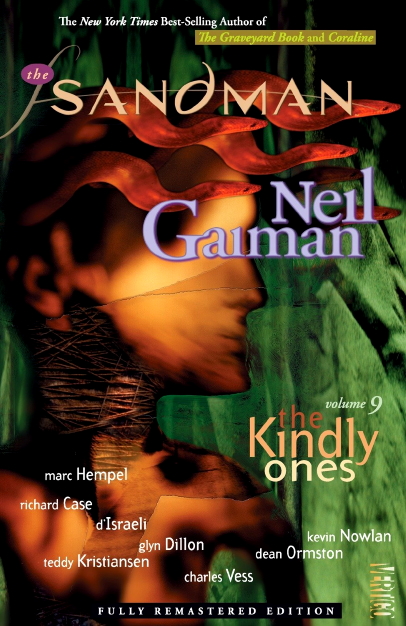 Publisher's synopsis
Publisher's synopsis:
In the longest Sandman story, Morpheus becomes the prey of the Furies--avenging spirits who torment those who spill family blood. A journey both begins and ends for the Lord of Dreams as threads and pieces building since the beginning of the series finally come together in a thrilling climax that forever changes the world of The Sandman.Sorry that this review is a little later in coming than I intended it to be.

So anyway, after the last book's cliff-hanger, let's see what
The Sandman Volume 9, "The Kindly Ones" has to offer.
Right up front, let me just say that this was a fantastic instalment of the series, but also a very dense one. There's so much to unpack and examine and interpret in this volume that there's just no way that I'll ever be able to cover everything of note in this review and still keep it at a length that isn't unbearably long. So, I'm gonna have to stick to just the most important elements of the story and try and cover as much as I can.
As I predicted in my last review, "The Kindly Ones" explains what caused the "reality storm" that occurred in "Worlds' End" and the meaning of the funeral procession of Gods, faeries, and members of the Endless family that we saw mournfully marching across the sky. The basic plot centres around Lyta Hall (the former wife of the deceased DC superhero Sandman) and the kidnapping of her toddler son Daniel. She assumes that Dream (a.k.a. Morpheus) has taken the boy because he once told her that he would one day return for the child, since the child was created in the Dreaming and is therefore a part of his realm. Crucially though, Lyta is wrong about the kidnapper's identity.
After receiving a bogus police report informing her that her child is dead, Hall suffers a nervous breakdown and descends into insanity. She searches for the goddesses of vengeance known as the Furies (who are actually the three witches from DC's old
The Witching Hour comic, who we've seen before, although they prefer to be called the Eumenides, which apparently translates roughly as the Kindly Ones). The three witches explain that although they cannot avenge Daniel's death for Lyta, they can, and will, avenge the mercy killing that Morpheus enacted on his own son Orpheus back in "Brief Lives".
This vow of vengeance sets in motion a narrative that brilliantly weaves together dozens of returning characters and separate storylines from the earlier volumes of
The Sandman. It really is amazing to see how many different story threads author Neil Gaiman has seeded throughout the series that tie up here. He revisits such sub-plots as Lucifer's retirement from ruling Hell; Desire's long-standing grudge against Morpheus; the faerie Cluracan's exploits and his sister Nuala having been gifted to Dream by the faerie queen Titania; the dream vortex Rose Walker and her grandmother Unity Kinkaid; Destruction having gifted Delirium with his talking dog Barnabas; Puck having escaped the faerie realm and taken up residence on Earth; Alex Burgess having been induced into a nightmare filled coma by Morpheus; Morpheus's killing of his son, and the aforementioned saga of Lyta Hall and Daniel.
In addition to the characters associated with the plot elements above, we also get smaller reappearances from the likes of Hob Gadling, Thor, Odin, Loki, Remiel the angel, Thessaly the witch, Zelda the spider woman, Death and Destiny of the Endless, and even a reborn Corinthian. Gaiman also revisits a number of sub-plots centred around the inhabitants of the Dreaming, including Matthew the raven, Lucien the librarian, Dream's janitor Mervyn Pumpkinhead, Cain and Abel, and the region of the Dreaming known as Fiddler's Green. Phew! This collection really is a smorgasbord of returning characters and plot lines.
Given how many narrative plates Gaiman keeps spinning in this volume, there must've been the potential for the whole narrative to end up as a jumbled, hard to follow mess. Thankfully, he pulls it all off brilliantly, tying the various story threads and returning characters into a cohesive and satisfying climax for the series (there is one more book to go, "The Wake", but as I understand it that's more of an epilogue to the series than a finale).
Unfortunately, while the writing in "The Kindly Ones" is extremely satisfying, I find artist Marc Hempel's work to be decidedly unsatisfying; it's blocky, angular, heavily stylized and quite unlike anything else that we've seen in the series. Here are some examples...
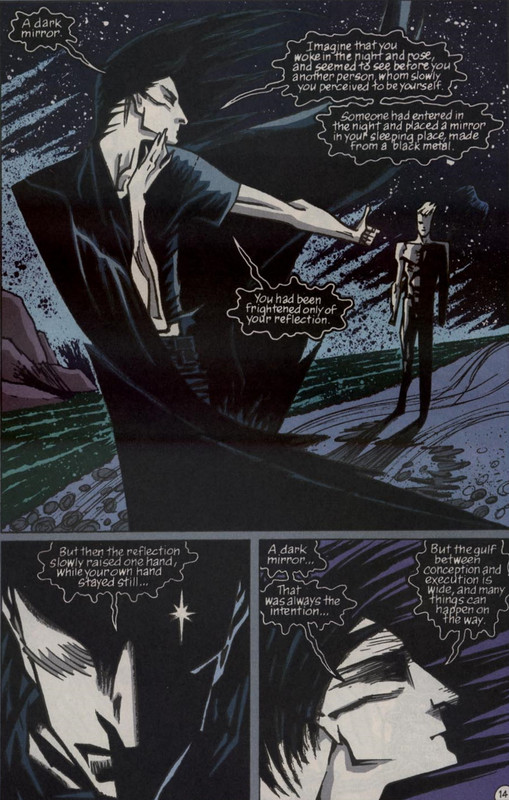

Now don't get me wrong, Hempel's art is excellent at putting the story across and his use of facial expressions to convey character emotion is very skilled, but, boy, is it ugly!
By contrast, the prologue to "The Kindly Ones", which was initially published in
Vertigo Jam #1 in mid-1993, is drawn by Kevin Nowlan and is absolutely beautiful to behold...
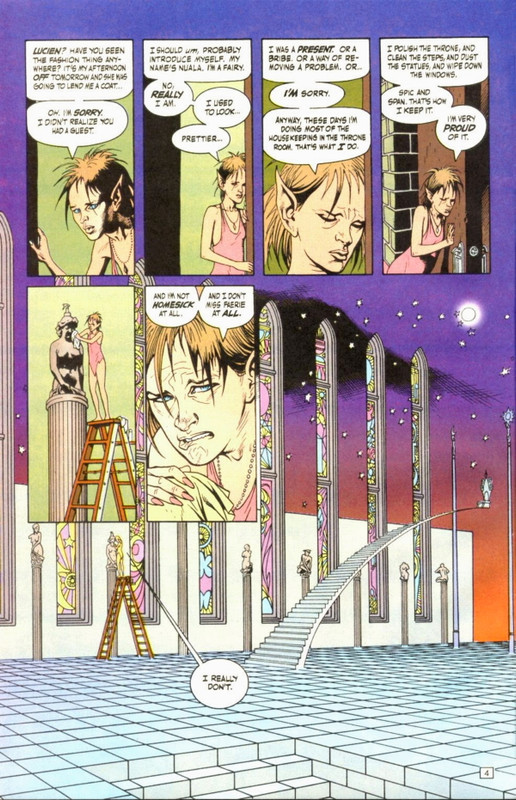
Just imagine if Nowlan had drawn all of "The Kindly Ones"! Personally, that would have been the way I'd have liked to have seen this volume rendered, but there we are.
Following the prologue, the story begins in earnest by showing us a close-up of a ball of yarn, held by Cynthia of the aforementioned Kindly Ones. As she winds the wool, the witch Mildred's voice asks off-panel, "Is it ready yet? Are you done?" "Nearly. There we go." Cynthia replies, as we see that the ball of yarn in her hands is almost fully rolled up. In opening like this, Gaiman is obviously alluding to the fact that his Sandman "yarn" is almost over and to the fact that the best storytellers make "something wonderful" out of these imaginary threads...
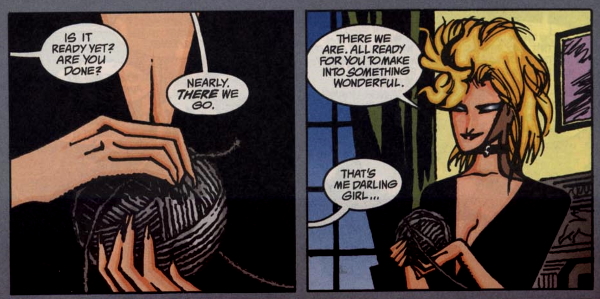
Later in this same scene, the witch Mordred makes a comment about knitting things for other people that is clearly a veiled metaphor for the creation of stories and fan reaction. She cynically complains, "It's never what they want, and if we give them what they think they want, they like it less than ever -- 'I never thought it would be like this.' 'Why can't it be like the one I had before?' -- I don't know why we bother?!" In writing this meta-commentary, Gaiman is neatly skewering any negative reaction that the fans might have to his conclusion to
The Sandman. This opening scene with the Furies also introduces a recurring motif involving threads and scissors cutting those threads, which Gaiman returns to a number of times throughout the book.
I must say, while I've been fairly critical of Gaiman's use of old, obscure DC characters in the series (although
Slam_Bradley helpfully informed me that exploring the forgotten corners of DC continuity was kind of Sandman and the Vertigo imprint's raison d'être at the start), this volume is the first time that the presence of these characters has really made sense to me. It also kind of serves to redeem or improve their earlier appearances in
The Sandman, as far as I'm concerned.
When we catch up with Lyta Hall and her son Daniel she already seems slightly mentally unstable, as a result of her husband's death – which she still mistakenly blames Dream for. But she's pushed further into a full mental breakdown by the kidnapping of her son, which, as I mentioned earlier, she also mistakenly blames Dream for. Lyta's decent into insanity is truly scary and unsettling to read, as she wanders the streets, flipping back and forth between the real world and a nightmarish dreamscape that we readers see juxtaposed with the inner-city reality of her surroundings...

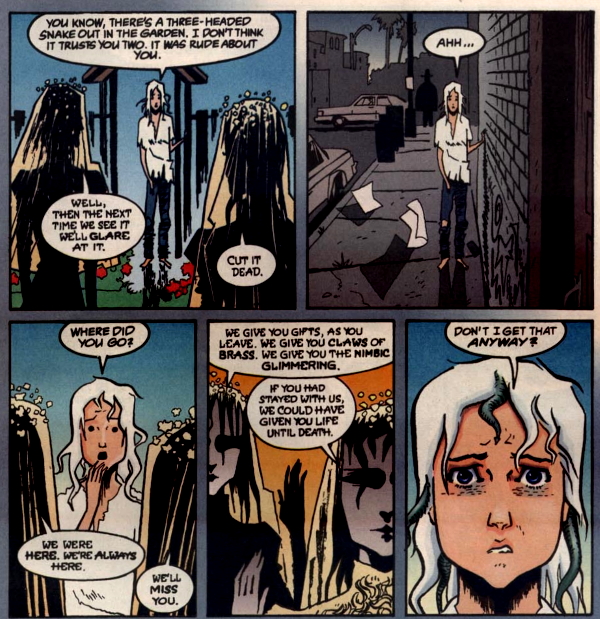
While Lyta's breakdown is legitimately frighting to read, something about it seems a little contrived to me. Or maybe a tad unbelievable, in spite of all that she's suffered. I don't know...I can't quite put my finger on exactly why I felt this way about this plot development, but I definitely did.
It turns out that Daniel has in fact been kidnapped by the Norse god Loki, with more than a little help from Puck – and I
knew that Puck would eventually return to make trouble! Loki really is an evil son of a bitch in this book and, as a result, Dream dispatches a newly reborn Corinthian nightmare (along with his faithful servant Matthew the raven) to find the child and deal with his kidnapper. I guess sometimes you just need to fight fire with fire.
The pair manage to find and rescue Daniel, with the Corinthian breaking Loki's neck and ripping his eyes out in their climactic fight. Loki begs the Corinthian to kill him, but the nightmare refuses. Eventually, Odin and Thor recaptured Loki, returning him to his place of punishment: bound to a rock, while snake venom is dripped into his face.
We also catch up with Rose Walker, who we first met back in volume 2, "The Doll's House". We learn that as a result of the mystical events of that story, Rose no longer ages and also cannnot feel emotion. She receives a supernatural message from her dead grandmother Unity Kinkaid, which results in her flying to England to meet with the curator of the retirement home where her grandmother lived before her death. While exploring the home, Rose comes face to face with Desire of the Endless, who is actually her Grandparent. The impact of this meeting results in Rose being able to feel once again and ties in with events shown way back in issue #1 of
The Sandman.
Thessaly the witch, who we met in "A Game of You", also appears, initially searching for Lyta, but ultimately being complicit in Dream's downfall. We catch up with Lucifer too, who is now running a swanky nightclub.
For me, one of the most surprising and satisfying plot developments in "The Kindly Ones" concerns the faerie Nuala, who has secretly fallen in love with Morpheus. I, for one, did not see that coming at all. In a book full of excellent writing, Gaiman does a particularly nice job with this unexpected plot twist. Since her first appearance, when she was given to Morpheus by Queen Titania of the faerie in "Season of Mists", Nuala has always been very much a background character, residing in Dream's palace, diligently doing her chores, and quietly falling in love with her Master.
In this volume, Nuala's brother Cluracan comes to take her back to the faerie realm, which Dream agrees to without much of a fight, which in turn really upsets the girl, who clearly worships him. As a parting gift, Dream enchants the pendant that Nuala wears around her neck, telling her that if she holds the pendant with both hands and calls him he will come to her and grant her one boon. As it turns out, this pendant-enchanting scene is hugely pivotal to the overall plot – not just of this book, but for the whole series. While it's tempting to think that Dream has given Nuala this gift because he too has some unspoken fondness for her – and I fully believe that to be the case on some level – it actually has a much deeper significance because Dream knows that Nuala will use it, calling him to her and thus forcing him to leave the safely of his realm. In doing so, he makes himself vulnerable to the wrath of the Furies, but he has no choice in this: by enchanting the pendant and thus sealing his fate, Dream is simply following what has been foretold in his brother Destiny's book.
Though this blind compliance to fate might seem strange or frustrating to the reader, we've seen before in the series that Dream is bound by his own set of rules and responsibilities, and is seemingly powerless to shirk from them – in this case, even when his life depends on it! Throughout the series we've seen Morpheus's enemies exploit his adherence to his own rules; the crux being that the very rules that define him also limit him. Morpheus's noble acquiescence to these rules gives a sense of impending doom to almost every page of this volume.
Before meeting his fate, Dream has one last meeting with his immortal friend Hob Gadling. In a touching couple of scenes, Gadling sorrowfully explains that his most recent wife died at the hands of a drunk driver and he is bitterly resentful that the driver wasn't caught. There's a terrible poignancy to these scenes, as Hob comes to fully appreciate immortality for the poisoned chalice that it really is...
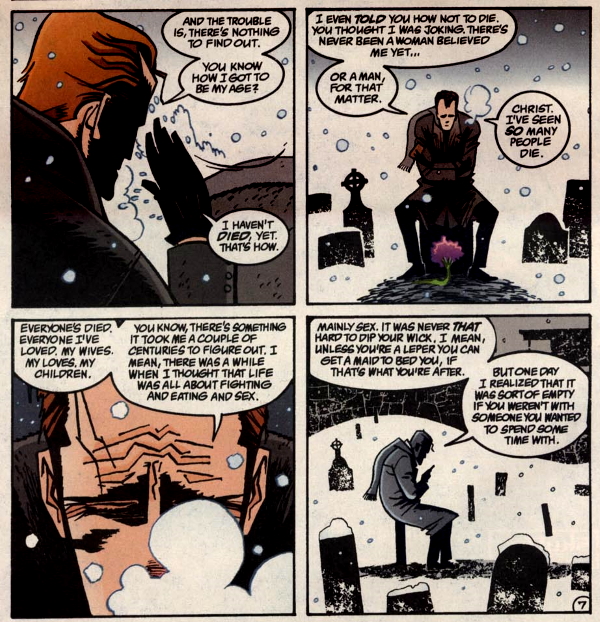

Dream also has words with the recently rescued Daniel, gifting him with the emerald "eagle" dreamstone and telling him that he will be the next Lord of Dream.
As the Furies launch their attack on the Dreaming, we see favourite residents of the realm – characters that as a reader I've become extremely fond of – brutally killed. The Kindly Ones take no prisoners! Interestingly though, we see these murders from the Furies' point of view; they never appear in the panels themselves, which gives these sequences a suitably nightmarish quality. Here's Mervyn Pumpkinhead's demise to illustrate what I mean...
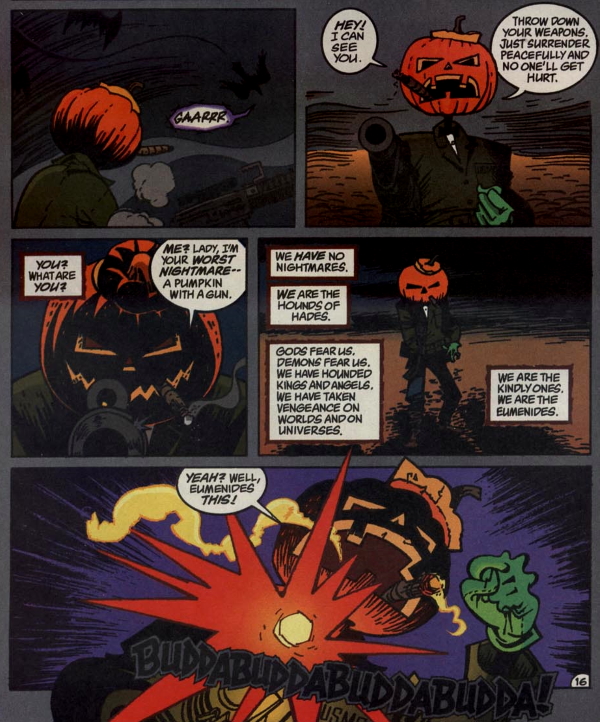
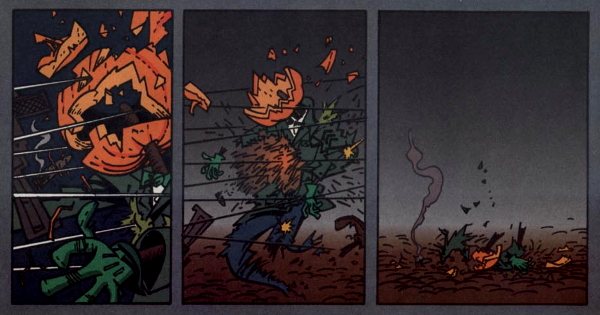
The death of each of these characters in the Land of Dream is absolutely heartbreaking – proof of how well Gaiman has built these characters, how well fleshed out they are, and, as a result, how much they mean to us.
As for Dream, he seems almost entirely resigned to his fate and barely puts up a fight at all, but then, as I said earlier, he is bound by his own rules and obligations. The climactic final confrontation between Morpheus and the Furies is not the epic, action-packed finale that we might expect from a fantasy comic. It's almost more like a philosophical war of viewpoints or moral rectitude, with both Dream and the Furies bound by the cosmic rules that govern them.
When the end finally comes, it is, fittingly, Dream's sister Death who not only takes him, but also eases his passing. She realises that part of the reason why he has been so passive in defending the Dreaming is because he wishes to leave his role as Dream of the Endless, but could not bring himself to simply abandon his duties, as his brother Destruction did.
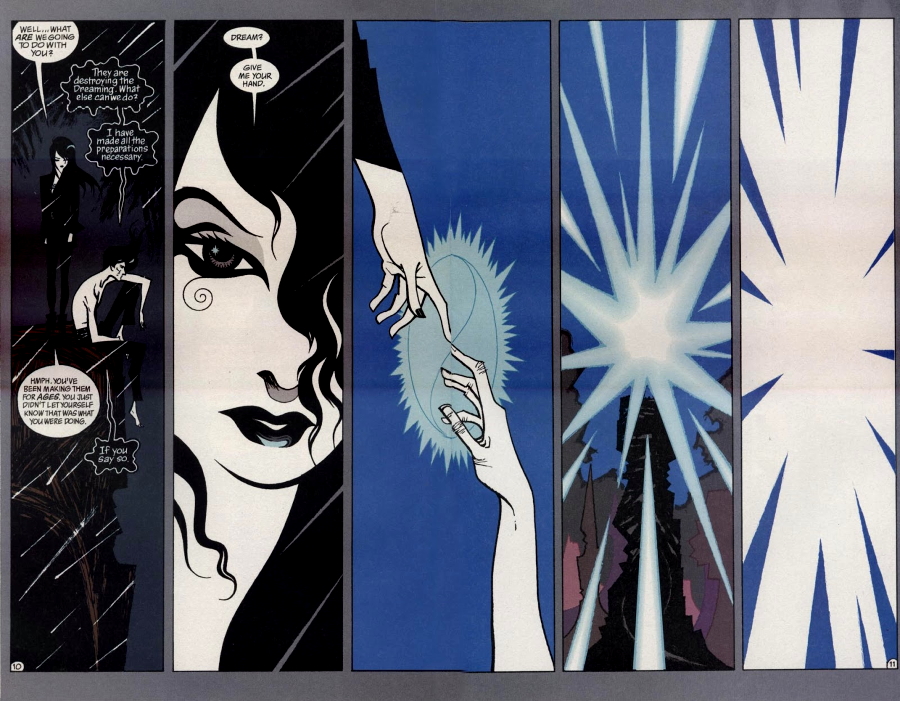
At the close of the book, we see Daniel in the Dreaming, playing with the emerald dreamstone that Morpheus bequeathed to him. It looks as if the child, who is suddenly magically grown up, has taken over the role of the Lord of Dream, as Morpheus predicted, albeit in a noticeably different form...
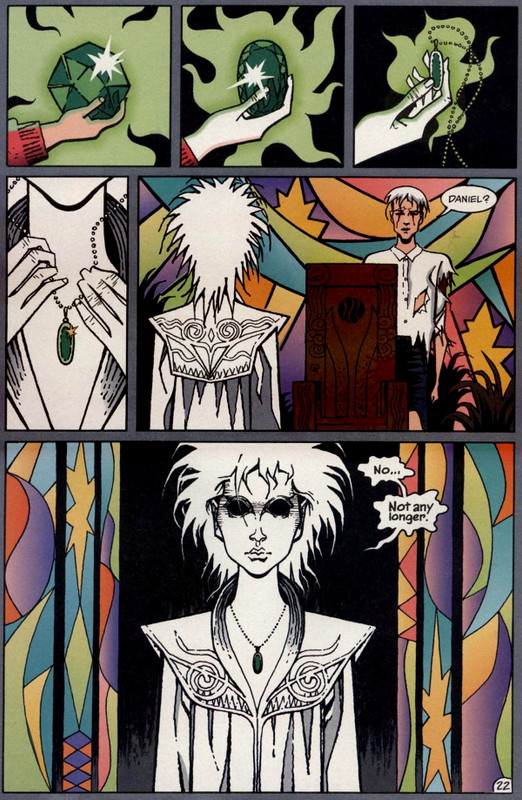
The final pages of this volume echo the beginning. We again see Cynthia of the Furies holding a ball of yarn and rolling it back up. The witch Mildred says off-panel, "There. For good or bad. It's done." Of course, this dialogue references both the Furies' revenge on Morpheus and the ending of the main arc of
The Sandman.
Overall, this is a fantastic book – dissatisfaction with Hempel's artwork not withstanding. You can feel Gaiman's confidence and ambition as a writer in the intricate plotting, the multiple themes he juggles, and the many sub-plots he skilfully blends together. It's a beautifully-crafted and immensely powerful story about vengeance and destiny, with echoes of Greek tragedy, as Dream finally has to face the consequences of his earlier actions. It's also a story all about replacements and obsolescence; Matthew wondering about the other ravens who preceded him, for example.
"The Kindly Ones" is a thumping good read and a real page turner that provides a satisfying sense of the Sandman narrative coming full circle and features some of the best and most focused writing we've seen from Gaiman in the series. You also get a real sense of things coming to an end, and its interesting to ponder how readers back in 1994 must've reacted to this story arc as each issue came out.